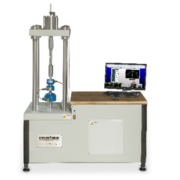How Does Tensile Testing Work?
 Tensile testing, also known as tension testing, is a type of mechanical test used to determine how a material responds to a stretching force. This test helps evaluate the mechanical properties of an object, such as metals, polymers, composites, and various other materials.
Tensile testing, also known as tension testing, is a type of mechanical test used to determine how a material responds to a stretching force. This test helps evaluate the mechanical properties of an object, such as metals, polymers, composites, and various other materials.
Performing a tensile test applies a load to specimen, and gradually increasing the load sometimes until failure or destruction. The tensile data is analyzed by using a stress-strain curve.
Interface stain gage load cells are commonly used in tensile testing due to their high precision and sensitivity. They work by measuring the strain in a material, which is directly related to the applied force. This strain data is then converted into force measurements. Learn more in Tension Load Cells 101.
Tensile testing is fundamental in test and measurement. It is used by researchers, testing labs, and engineers across industries including infrastructure, medical, manufacturing, aerospace, consumer goods, automotive, energy, and construction.
How Tensile Testing Works
Tensile testing is essential in materials science and engineering to understand the material’s behavior under tension and to ensure its suitability for specific applications.
First, a specimen of the material is prepared with a specific shape and dimensions. This sample is carefully controlled to meet testing standards based on the test plan.
Interface supplies a variety of load cells for these tests. The load cell is typically mounted in a tensile testing machine. The tensile test machine has two separate jaws, one of which will move away from the other at a controlled rate during the test. As it moves away, it is pulling on the material, stretching it until it the test is complete, or it breaks. This is also referred to as testing to failure or destruction. The controlled rate is called the strain rate, and materials will behave differently under different strain rates.
The specimen is then securely mounted in a testing machine, which is usually called a tensile testing machine or universal testing machine. The load cell is positioned in such a way that it bears the load applied to the specimen during the test.
Load cells are commonly used in tensile testing to measure and record the force or load applied to a specimen during the test. These sensor devices are crucial for accurately determining the mechanical properties of materials under tension.
The testing machine applies a pulling force (tensile force) to the specimen along its longitudinal axis. The force is gradually increased at a constant rate, causing the specimen to elongate.
As the tensile testing machine applies a pulling force to the specimen, the load cell measures the force in real-time. This force measurement is typically displayed on a digital instrumentation device or recorded by a data acquisition system.
The recorded data, including the applied force and the corresponding elongation or deformation of the specimen is usually plotted on a stress-strain curve for analysis. The stress-strain curve provides valuable information about the material’s mechanical properties, including its ultimate tensile strength, yield strength, Young’s modulus, and elongation at break.
Engineering Checklist for Tensile Test Plans
- Identify the Purpose of the Tensile Test
- Select the Material and Test Standard
- Define the Mechanical Properties
- Determine the Specific Mechanical Properties for Evaluation
- Common properties include tensile strength, yield strength, modulus of elasticity (Young’s modulus), elongation, reduction in area, stress-strain curve characteristics
- Establish Test Conditions
- Include temperature, strain rate and testing environment
- Define Sample and Specimen Requirements
- Determine Measurement Accuracy Requirements
- Review the specifications of your load cell
- Prepare Instrumentation and Equipment
- Plan for Data Recording and Reporting
- Review Compliance Requirements and Safety Standards
- Document Test Plan
- Publish Verification and Validation Processes
- Report Results
Defining measurement requirements for tensile tests by specifications is a crucial step in ensuring that the tests accurately and reliably assess the mechanical properties of materials.
Tensile Testing Terms to Know
Stress: Stress is the force applied per unit cross-sectional area of the specimen and is usually denoted in units of pressure. Stress is calculated by dividing the measured force by the cross-sectional area of the specimen. The load cell’s force measurement ensures that the stress values are accurate and precise. Simply, stress is the amount of force applied over a cross-cross-section.
Strain: Strain represents the relative deformation of the material and is the change in length (elongation) divided by the original length of the specimen. Strain is the amount of elongation in a sample as it is stretched or squashed.
Elastic Region: In the stress-strain curve, the initial linear region where stress is directly proportional to strain is known as the elastic region. Here, the material returns to its original shape when the load is removed. As soon as a material is placed under any load at all, it deforms. Visually, the deformation may not be noticeable, but right away, the material is deforming. There are two types of deformation: elastic (not permanent) and plastic (permanent).
Yield Point: The yield point is the stress at which the material begins to exhibit permanent deformation without an increase in load. It marks the transition from elastic to plastic deformation.
Ultimate Tensile Strength (UTS): UTS is the maximum stress the material can withstand before breaking. It is the highest point on the stress-strain curve. If the material is loaded to its UTS, it will never return to its original shape, but it can be useful in engineering calculations, as it shows the maximum, one-time stress a material can withstand. Load cells can detect the exact moment of specimen failure, such as fracture or breakage. This information is crucial for determining the ultimate tensile strength and other mechanical properties of the material.
Elongation at Break: Elongation at break is the amount the specimen stretches before it breaks, expressed as a percentage of the original length.
Load cells can also be used for real-time monitoring and control during the test. Test operators can set specific load or strain rate parameters to control the testing machine’s operation and ensure the test is conducted within specified conditions.
Load cells play a safety role by providing feedback to the testing machine’s control system. If the load exceeds a certain threshold or if the load cell detects an anomaly, the testing machine can be programmed to stop or take corrective actions to prevent damage to the equipment or ensure operator safety.
To discuss Interface products and experience in tensile testing, be sure to reach out to our global representatives in the field or contact us. We are always here to help!








